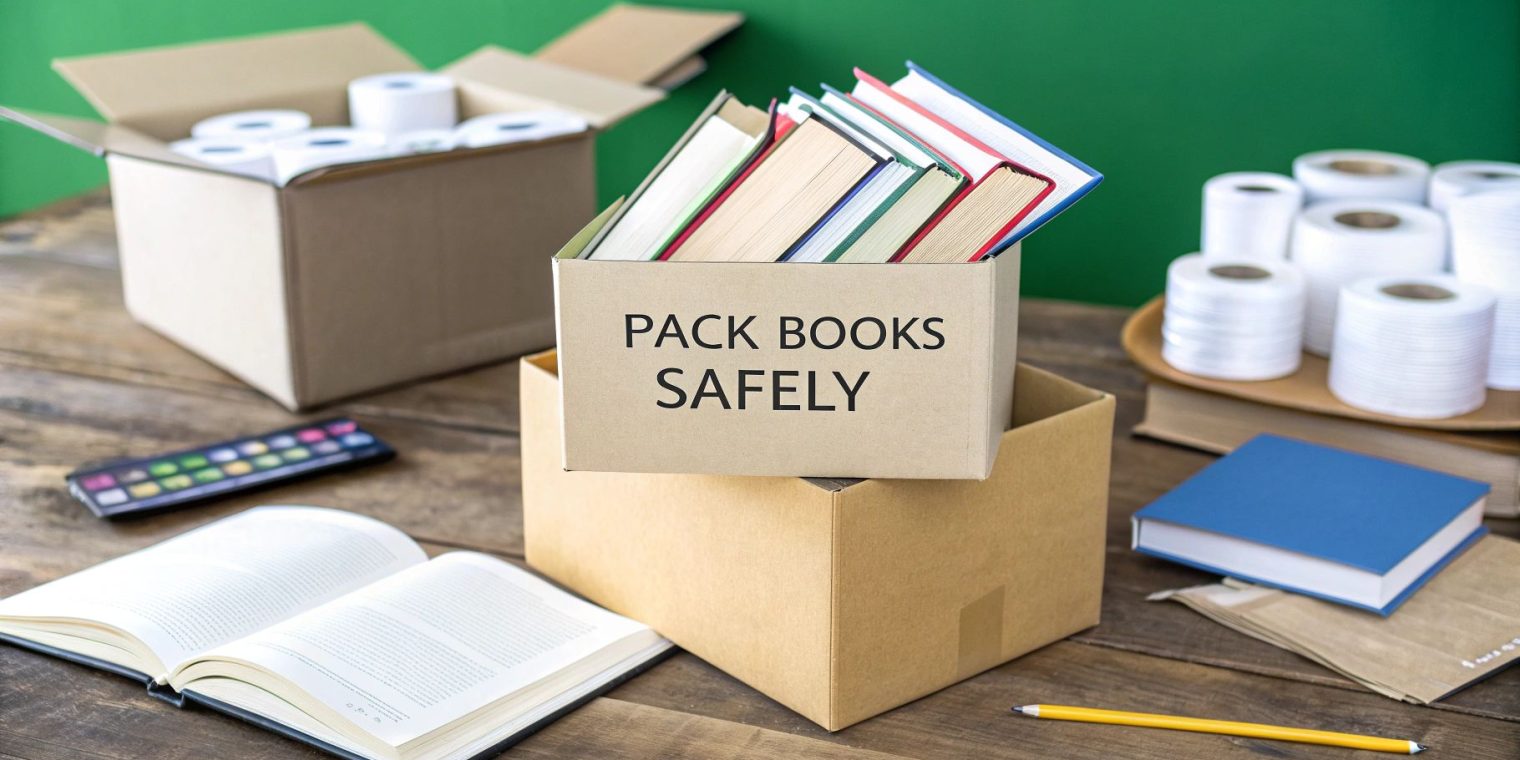When it comes to packing books, I’ve learned two golden rules over countless moves: use small, sturdy boxes, and keep them light. It’s so easy to grab a big box and just start filling it, but trust me, that’s a one-way ticket to a strained back or, worse, a box that bursts open mid-move. Your library deserves better treatment than that.
That treasured collection of yours is, without a doubt, one of the heaviest things you’ll own. Getting the packing wrong can lead to heartbreak—damaged spines, torn dust jackets, and a whole lot of moving day stress. But if you break it down into a few simple stages, it’s completely manageable.
This image lays out the basic game plan: get your supplies, sort your books, and then pack them up the right way.
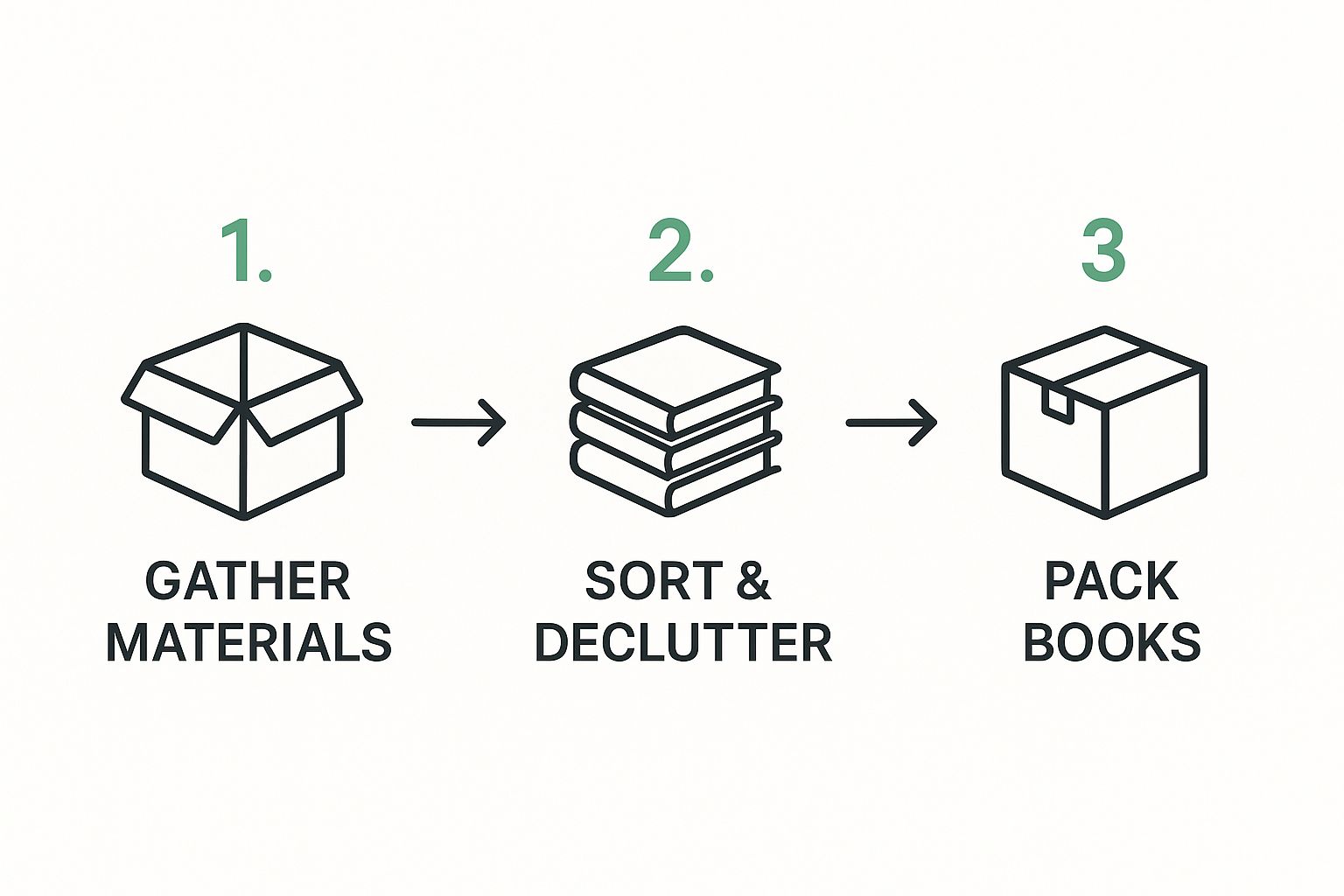
Following this workflow helps you avoid that feeling of being overwhelmed and makes sure nothing gets missed. It transforms what seems like a massive chore into a straightforward project.
Getting a Handle on Weight and Protection
The first thing to get your head around is just how surprisingly heavy books are. Even with digital readers, physical book sales in Australia are holding strong, which means we’re all still moving a lot of them! You can read more about recent market trends over at Books+Publishing.
A single hardcover can easily weigh 1-2 kilograms, and that adds up fast. To stay on the right side of workplace health and safety guidelines and just to be kind to your own back, professional removalists always aim to keep boxes under 15 kilograms.
My Two Cents: Don't just guess the weight. After you've packed a box, give it a test lift. If you have to grunt and strain, it’s too heavy. It's far better to have a few extra, lighter boxes than a handful of back-breakers.
The Three Main Ways to Pack Your Books
Now, let’s talk about how the books actually go in the box. This is just as critical as the box itself. After years of doing this, I’ve found there are really three core methods, and each one serves a different purpose.
To help you decide what’s right for your collection, I've put together a quick comparison of these packing styles.
Book Packing Methods At a Glance
| Packing Method | Best For | Pros | Cons |
|---|---|---|---|
| Laying Flat | Hardcovers, textbooks, large coffee table books | Protects spines from bending; very stable | Can be less space-efficient |
| Spine Down | Paperbacks | Supports the book's structure like a bookshelf | Not ideal for fragile or antique books |
| Standing Upright | Filling gaps, same-sized paperbacks | Uses space efficiently | Can lead to shifting if not packed tightly |
Each technique has its place. You'll likely use a mix of all three to get everything packed securely and efficiently.
Here’s a closer look at when and why you’d use each one:
-
Laying Flat: This is my go-to for hardcovers and those big, heavy art or coffee table books. Laying them flat is the absolute best way to protect their spines and stop the pages from getting bent or warped.
-
Spine Down: Perfect for your paperback collection. Stacking them with the spines down is a lot like how they’d sit on a shelf—it supports their structure and helps them keep their shape.
-
Standing Upright: I often use this method to fill in the odd gaps in a box. You can stand paperbacks up like soldiers, but the key is to pack them in snugly. Any wiggle room means they can shift, slide, and get damaged during transit.
Choosing the Right Supplies for the Job
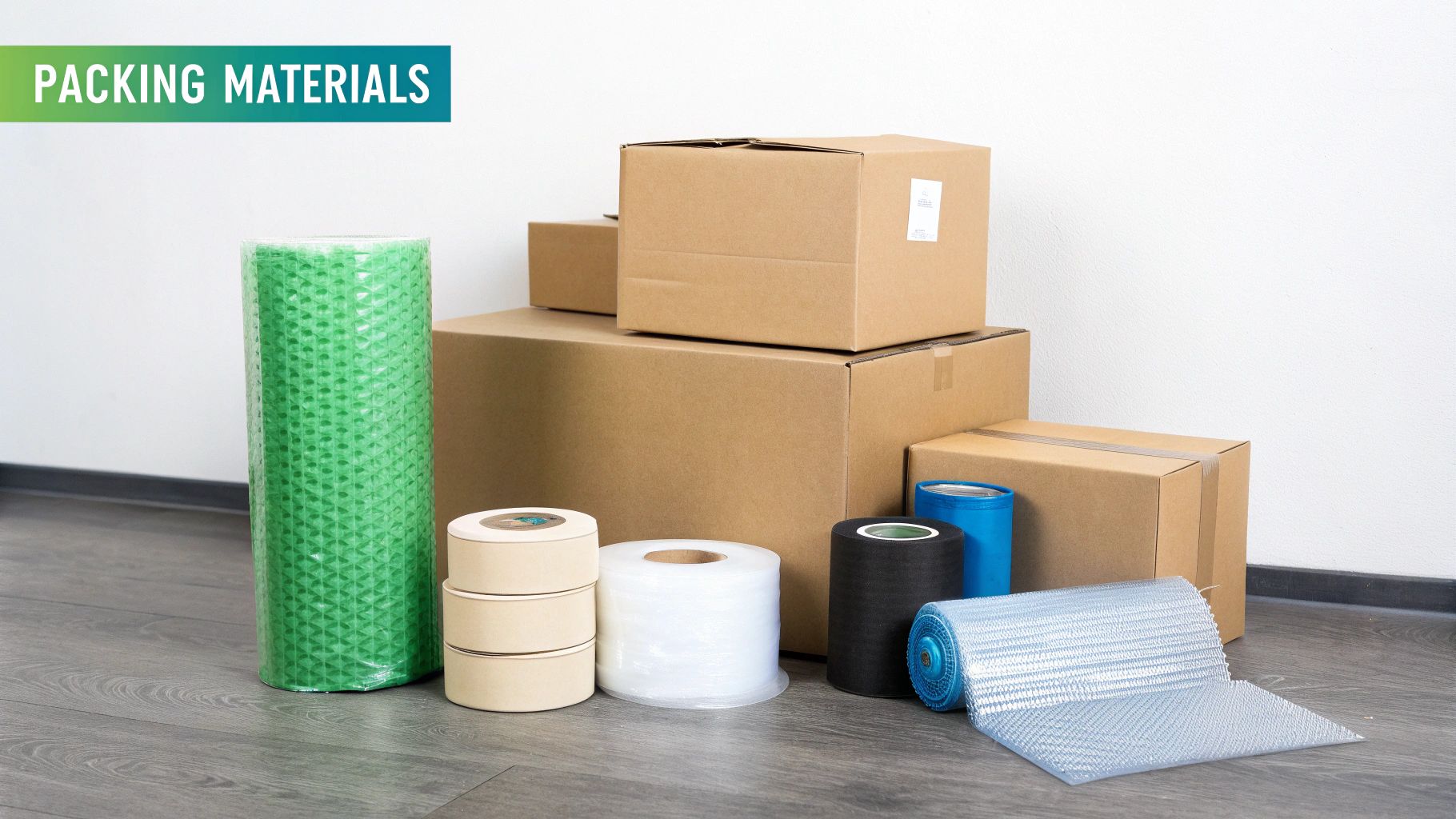
Before you even think about packing a single book, getting your supplies sorted is absolutely crucial. Trust me on this one—trying to save a few dollars here almost always ends in a moving day nightmare. Those flimsy supermarket boxes might seem tempting, but they simply aren't designed to handle the concentrated weight of books.
What you really need are small, double-walled cardboard boxes. I can't stress this enough. Their smaller size is a built-in safety feature; it stops you from making the box so heavy that you can't lift it, or worse, that the bottom falls out. The double-walled design is your best defence against boxes getting crushed when they're stacked in the moving truck.
Your Must-Have Packing Kit
It's not just about the boxes, though. A few other key items are essential for getting your books from your old home to your new one without a scratch.
- Quality Packing Tape: This is no place to be frugal. A good, strong tape is the only thing standing between your books and the floor. Make sure it's reliable.
- Clean Packing Paper: Perfect for lining boxes and filling in any empty spaces to stop books from shifting around. Steer clear of newspaper—the ink can easily rub off onto covers and pages, leaving stains that are impossible to get out.
- A Good Marker: When you're surrounded by dozens of identical-looking boxes, clear labelling is a lifesaver. A thick, permanent marker is non-negotiable.
Even with e-books being so popular, Australians are still buying and moving plenty of physical books. It's just common sense to use the right gear when a standard box of books can easily weigh 10 to 15 kilograms.
Where to Get Your Gear
You don't have to spend a fortune sourcing these materials. While specialised moving supply shops are an excellent choice, you can also find everything you need at local hardware stores or online. For a comprehensive list of places, check out our guide on where to buy moving boxes.
A Pro Mover's Tip: Take a look at what you already have. Wheeled suitcases are an absolute game-changer for moving heavy hardcovers. They're literally designed to carry heavy loads, and the wheels make getting them to and from the truck effortless.
Here is the rewritten section, crafted to sound like it was written by an experienced human expert.
Getting Your Books in Order Before You Box Them Up
Let's be honest, moving is a massive job. But it's also the perfect excuse to finally tackle that book collection you’ve been meaning to sort through for ages. Think of it less as a chore and more as a chance to curate your personal library. Putting in a bit of effort here, before a single book touches a box, will make a huge difference. You'll not only lighten the load but also make packing faster and unpacking on the other side so much smoother.
The first thing to do is make three piles: Keep, Donate, and Sell. Now, be ruthless. That university textbook you haven't opened in a decade? It's time. The novel that was just… alright? Let it go. Parting with books you know you won't miss is the single best way to save yourself time, back-breaking effort, and money on packing supplies. Every book you don't have to pack is a win.
Smart Sorting Makes for an Easier Move
Alright, you've got your "keep" pile. The temptation is to sort them by genre, just like on your bookshelf, but for moving, function beats form. It’s far more practical to group books by their size and shape.
- Hardcovers vs. Paperbacks: Start by splitting your collection into two main groups: hardcovers and paperbacks. Your hardcovers are usually pretty uniform and heavy, so they fit snugly together. Paperbacks, on the other hand, come in all sorts of odd sizes and are great for filling in those awkward gaps in a box.
- Size Matters: Now, take it a step further. Within your hardcover pile, group them by size. Do the same for your paperbacks. When you pack books of a similar height and width together, you create a solid, stable brick of books. This stops them from sliding around and getting their corners dinged up during transit.
A Tip from Experience: I always make a small, separate pile for the really special books – that old leather-bound classic from your nan or a signed first edition. These treasures deserve the VIP treatment. I wrap them individually in packing paper and make sure they go into a clearly marked box. If you can, keep this box with you in the car. Oh, and giving your keepers a quick wipe-down now means you’ll have clean, dust-free books ready for their new shelves.
Proven Techniques for Packing Books Securely
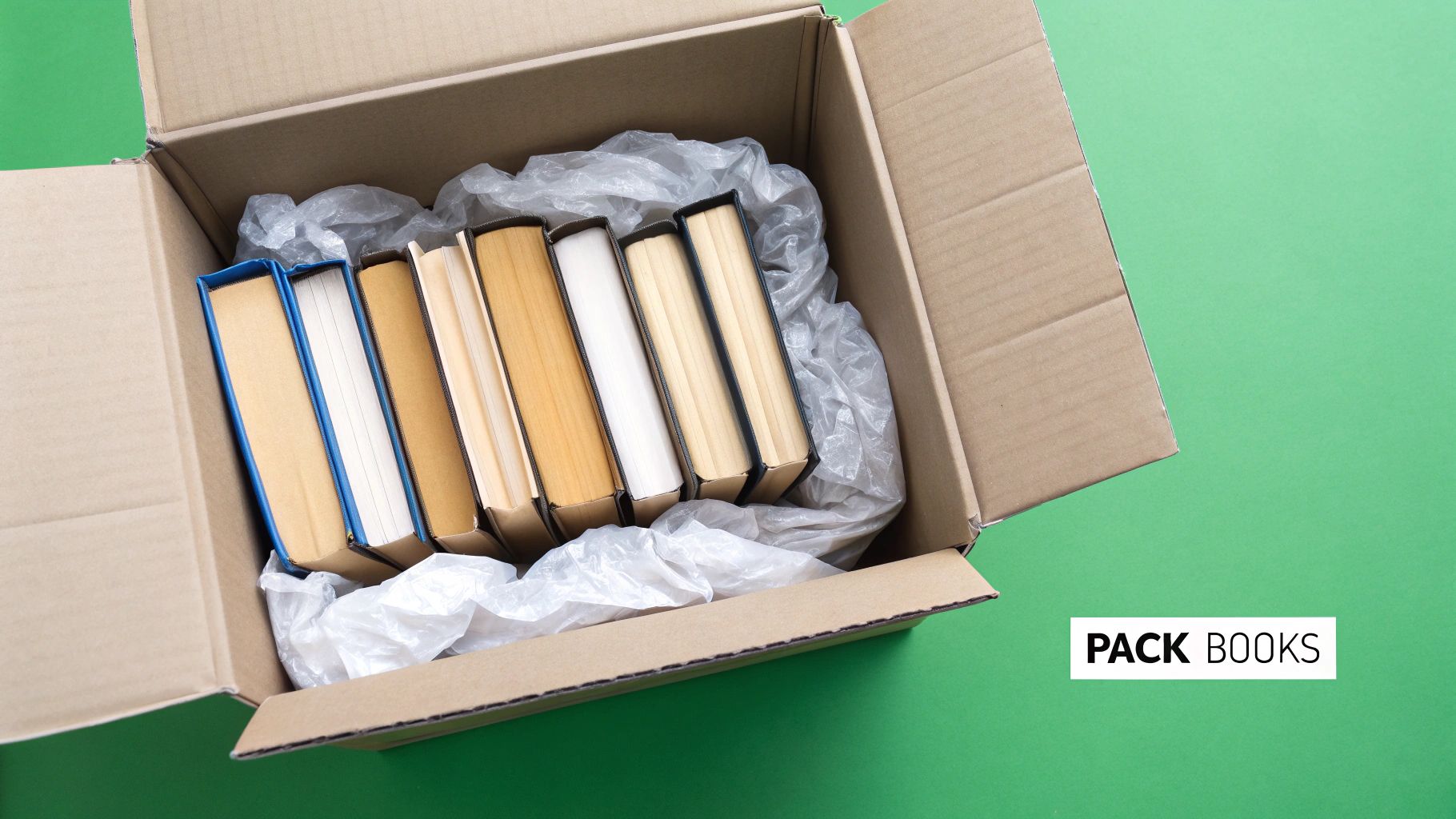
Alright, you've sorted your books and gathered your supplies. Now for the most important part: the actual packing. How you load your books into a box is just as critical as the box itself. The aim is to create a solid, tightly packed cube with zero room for things to slide around. It’s that internal shifting that leads to bent corners, creased covers, and torn pages.
Before a single book goes in, always create a soft landing pad. Just crumple up some packing paper and line the bottom of the box. This simple step provides a crucial buffer against all the bumps and jolts your boxes will face on the road. With that base in place, you’re ready to start loading.
Finding the Right Packing Style
There isn't a one-size-fits-all method for packing books; the right technique really depends on the type of book you're dealing with.
For your hardcovers and those big, heavy coffee table books, the best approach is to lay them flat. I always start with the heaviest one at the very bottom and then stack progressively lighter books on top. If you can, alternate the direction of the spines with each layer—this helps keep the stack level and stable.
Paperbacks are a bit more forgiving. You can stand them up on their bottom edge with their spines flush against the side of the box, just like they’d sit on a shelf. The key here is to make sure the paper edges face upwards. A common mistake is packing a book with its spine facing up, which can cause the glue to weaken and the pages to sag.
The Golden Rule of Packing Books: Fill every single gap. Seriously, every last one. Use crumpled packing paper, old tea towels, or even soft socks to plug any empty spaces. Once you think a box is full, tape it shut and give it a gentle shake. If you can feel or hear anything moving, it’s not done yet. Open it back up and add more padding.
With Australia’s net migration figures hitting 440,330 in the year to April 2025, more households are on the move than ever. This boom has really highlighted the need for smart, safe packing. Official moving guidelines suggest keeping individual box weights between 12 to 15 kilograms and packing books flat with plenty of cushioning—advice that aligns perfectly with what we see works best. You can read more on how Australia’s population shifts are impacting moving trends at the Institute of Public Affairs.
Protecting Your Most Valued Editions
Your rare first editions, antique family heirlooms, or just deeply sentimental books need some extra TLC. These are the ones that are often irreplaceable, so they deserve more than just being tossed in with the rest. The techniques here are quite similar to how you’d handle other delicate belongings.
For these special volumes, I always recommend:
- Wrapping them individually in acid-free packing paper. This protects the dust jacket and the binding from scuffs and moisture.
- For an added layer of protection, you might even place each wrapped book inside a padded mailer before putting it in the box.
- Pack them snugly into their own small, clearly labelled box. Don't mix them with general-purpose books.
This little bit of extra effort is well worth it to ensure your most treasured books arrive at your new home looking just as good as when they left. For a deeper dive into protecting delicate possessions, our guide on how to pack fragile items for moving has some great, comprehensive tips.
Labeling and Stacking Boxes Like a Pro
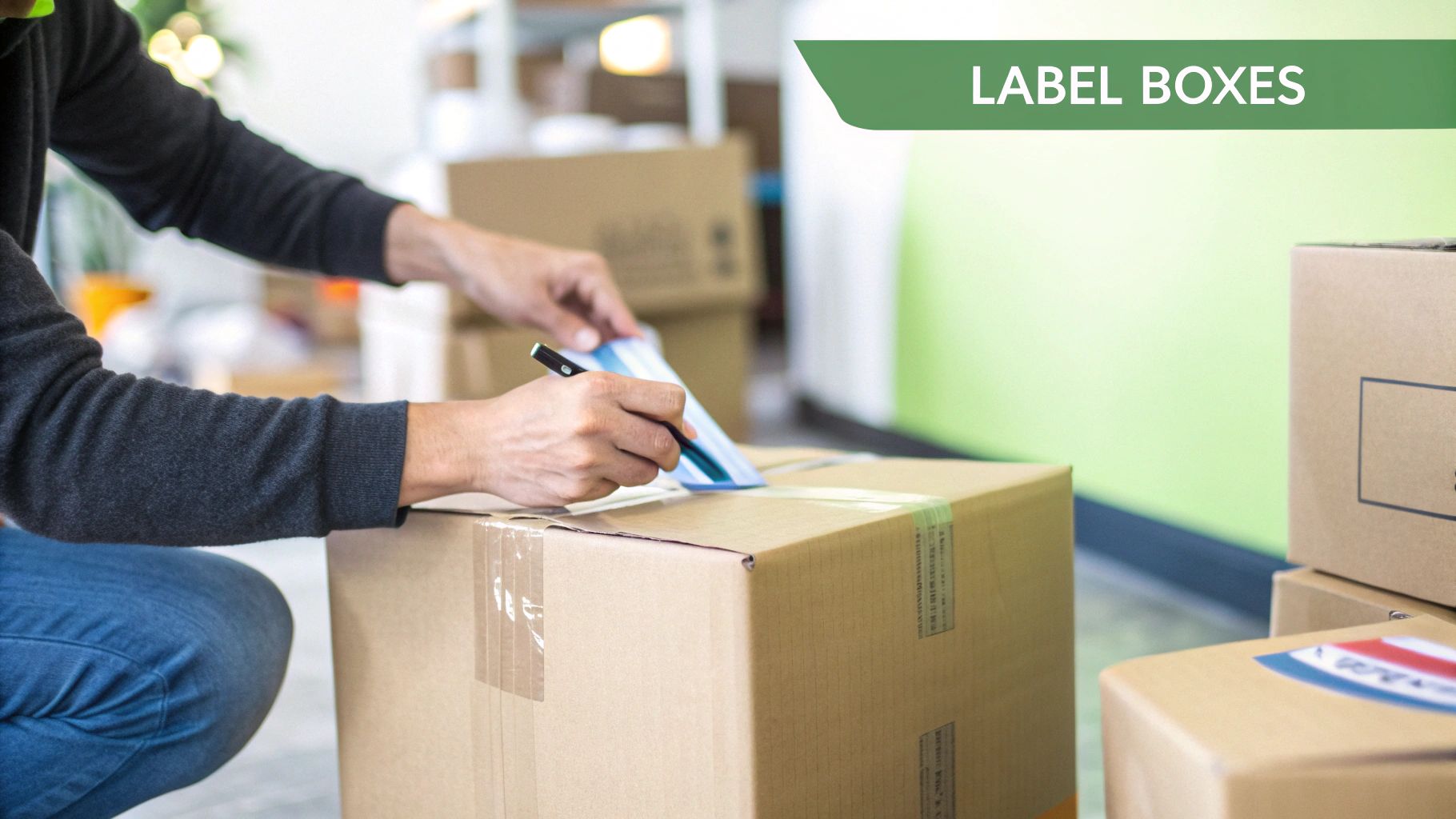
Honestly, your packing job is only half-done until the box is properly sealed and labelled. This is the part that separates a smooth, organised move from a chaotic mess. Getting your labelling system right from the start will save you a world of headaches on moving day and during unpacking.
First things first, before you even think about sealing the top, double-check the bottom. I always run a few extra strips of quality packing tape along the bottom seam. It’s a small step, but it’s crucial for stopping the bottom from blowing out under the weight of all those books.
Once you're taped up, grab a thick, dark marker and get to work.
The Smart Labelling System
Clear, informative labels are a gift to your future self. Don't just scrawl "stuff" on the side and call it a day. For book boxes, I’ve found a simple three-part system that works every time:
- The Contents: A simple, clear 'Books' is all you need.
- The Destination Room: Where is this box going? Mark it 'Office', 'Living Room', or 'Bedroom 2'.
- The Warning: This is non-negotiable. Write 'HEAVY' in big, bold letters. Make sure you write it on at least two sides so it’s always visible.
This method tells your removalists (and you!) exactly what's inside, where it needs to go, and to lift with their knees, not their back.
A Quick Tip from Experience: When you start piling up the finished boxes, always keep the book boxes on the floor. Never, ever stack them on top of boxes filled with lighter, more delicate items. Their weight will crush weaker boxes in a heartbeat.
This principle becomes even more important when loading the truck. Book boxes create an excellent, solid base for everything else. By loading them first, you build a stable foundation that stops things from shifting and crushing your other gear during the move. A bit of smart stacking really does go a long way.
Alright, here is the rewritten section with a more natural, human tone, following all the specific instructions.
Your Book-Packing Questions, Answered
Even with the best intentions, packing up a personal library always brings up a few questions. It’s one of those jobs that looks simple from a distance, but gets complicated once you're staring at towering stacks of paperbacks and hefty hardcovers. Let's tackle some of the most common queries I run into.
Getting these details right can make the whole process feel a lot less daunting and a lot more organised.
How Many Books Should I Actually Put in a Box?
This is the big one, and the real answer has nothing to do with a specific number of books—it's all about weight. My hard-and-fast rule is to keep every box under 15 kg. Trust me, your back will thank you, and so will the bottom of the moving box.
So, what does that look like in practice? For a standard small book box, you're usually looking at:
- Roughly 20-30 regular-sized paperbacks.
- About 15-20 standard hardcovers.
My best tip? Just do a quick lift test. If you have to grunt and strain to get the box off the floor, it’s too heavy. It's always smarter to grab another box than to risk one splitting open on the driveway or, even worse, causing an injury.
What’s Better: Packing Books Flat or Standing Them Up?
For most of your collection, especially those precious hardcovers, packing them flat is the way to go. Laying them down horizontally is the best way to protect their spines, stopping them from getting bent or warped while they're rattling around in the truck.
Now, if you’re tight on space and need to stand them up, make sure you do it like you're loading a bookshelf. Place them in the box with their spines firmly against the bottom. This gives them the structural support they need. Never, ever pack books with their paper edges down—it’s a surefire way to get bent, dog-eared pages. For more general moving advice, you can find answers from experts on the top questions about moving house.
Can I Just Use a Suitcase for My Books?
You absolutely can! In fact, using a wheeled suitcase is one of my go-to moving hacks, particularly for those super heavy art books or university textbooks. Suitcases are designed to take a beating and handle a lot of weight, and the wheels make getting them to the moving truck a breeze.
The key is to pack them in tight. Use crumpled packing paper, old tea towels, or even socks to fill in any gaps so the books don't slide around and damage each other.
At Emmanuel Transport, we get how much care goes into packing up a beloved book collection. If you need a hand with the heavy lifting or want a team of professionals to manage your entire move in Perth, we're here to help. Get a free, transparent quote for a seamless and stress-free move by visiting us at https://emmanueltransport.net.au.

